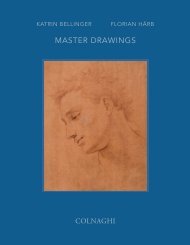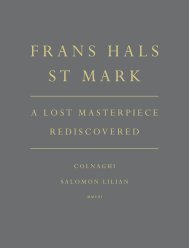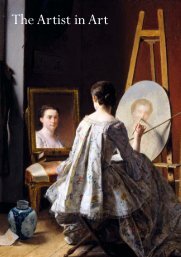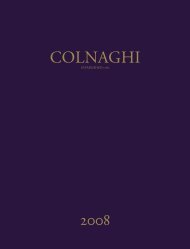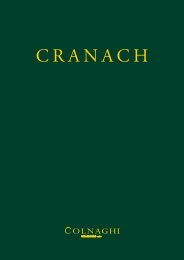2007 Catalogue - Colnaghi
2007 Catalogue - Colnaghi
2007 Catalogue - Colnaghi
You also want an ePaper? Increase the reach of your titles
YUMPU automatically turns print PDFs into web optimized ePapers that Google loves.
10<br />
Jean-Louis Demarne, called Demarnette<br />
(Brussels 1744 – 1829 Paris)<br />
In its evocation of rural life The Horse Market looks<br />
back to Dutch art of the seventeenth-century, which<br />
was to be a lifelong source of inspiration for Demarne.<br />
The merriment of the scene and the grey piebald horse<br />
recalls the works of the van Ostade brothers and<br />
Philips Wouwerman. As with Wouwerman’s A Horse<br />
Fair in Front of a Town in the English Royal<br />
Collection, 1 the viewers attention is drawn to the<br />
centre of our work where the light is focused. There is<br />
also an echo of Salomon von Ruysdael in the open<br />
river landscape in the distance. A possible pendant<br />
to our picture The Village Fête, with the same<br />
measurements and a similar composition was in the<br />
collection of Henry Say and sold, together with<br />
twenty-one other pictures, by the George Petit Galerie<br />
on 30 Nov 1908 in Paris.<br />
At the age of twelve Demarne left his native Brussels<br />
for Paris, where he studied history painting under<br />
Gabriel Briard (1729 - 77). Having failed to win the<br />
Prix de Rome in 1772 and 1774, he concentrated on<br />
landscape and genre painting, in which he was heavily<br />
influenced by such Dutch seventeenth-century masters<br />
as Aelbert Cuyp, the van Ostade brothers, Adriaen van<br />
de Velde and Karel Dujardin. In this respect, Demarne<br />
pursued a Northern tradition of landscape painting,<br />
while his contemporaries, such as Achille-Etna<br />
Michallon, adhered to the Southern tradition of the<br />
The Horse Market<br />
Oil on canvas<br />
21 1 /2 x 32 1 /4 in. (55 x 82cm.)<br />
38<br />
classical landscape which had been recently revived by<br />
Valenciennes in the guise of the paysage historique.<br />
Works by Dutch artists were highly sought after in<br />
Paris at the time, and, in reviving their art and<br />
transposing it to a contemporary setting, Demarne<br />
won a strong following among leading connoisseurs<br />
and artist-collectors of the time: Josephine Bonaparte<br />
(who owned four paintings), Carle Vernet, the Baron<br />
Gros and M. Thomas Henry. He was also popular in<br />
Russia, and many of his best works were bought by<br />
Russian aristocrats (for example, Prince Youssoupoff).<br />
Arguably his biggest supporter was the Comte de<br />
Nape, who owned thirty-one pictures by the artist and<br />
published a short biography of him in 1817.<br />
In 1783 Demarne was made an associate of the<br />
Académie but he did not become a full member.<br />
Seemingly uninterested in official honours, he was a<br />
very commercially minded artist, exhibiting in the<br />
Paris Salons from 1783 to 1827. Largely apolitical, he<br />
did not participate in the French Revolution and was<br />
only a very peripheral figure in Napoleon’s patronage<br />
of the arts. Demarne was a prolific artist and the<br />
repetitious nature of his works makes it difficult to<br />
establish a chronology for his oeuvre. His principal<br />
subjects were the village or town fair and road scenes.



